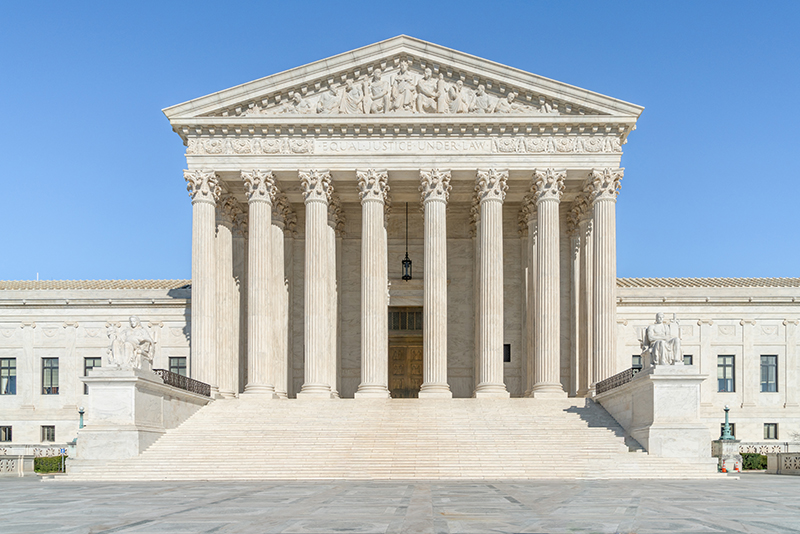SCOTUS Keeps Title 42 Going — For Now
On December 27, the Supreme Court issued an opinion in Arizona v. Mayorkas, staying the end of Title 42 in response to an application for a stay filed by a coalition of states who are seeking to keep those CDC orders, which direct the expulsion of illegal migrants in response to the Covid-19 pandemic, in place. Basically, Title 42’s going to be around until at least February — unless it isn’t.
What’s Going On? To understand what’s going on, here is a truncated version of a Title 42 timeline that appeared in my December 21 post:
March 11, 2020: The World Health Organization declares a global Covid-19 pandemic.
March 20, 2020: CDC issues its first Title 42 order, applicable to illegal entrants crossing the Mexican and Canadian borders and other inadmissible aliens.
April 20, 2020: CDC extends its Title 42 order.
May 19, 2020: CDC extends its Title 42 order and amends it to apply to coastal borders as well.
October 13, 2020: CDC extends its Title 42 order.
February 17, 2021: CDC issues a new Title 42 order excepting unaccompanied alien children from expulsion under Title 42.
August 2, 2021: CDC extends its amended Title 42 order.
September 16, 2021: Judge Emmet Sullivan, of the U.S. District Court for the District of Columbia, enjoins the expulsion of illegal entrant adults travelling with children in “family units” under Title 42 in Huisha-Huisha v. Mayorkas.
March 4, 2022: The U.S. Court of Appeals for the District of Columbia (D.C. Circuit), in response to a government appeal of Judge Sullivan’s order in Huisha-Huisha, affirms DHS’s authority to expel illegal migrants under Title 42, but not to places where those aliens would be persecuted or tortured.
April 1, 2022: Biden administration announces that Title 42 will end on May 23, 2022.
April 3, 2022: The states of Arizona, Louisiana, and Missouri file suit in the U.S. District Court for the Western District of Louisiana against CDC, alleging that its termination of Title 42 violates the Administrative Procedure Act (APA), in a case captioned Louisiana v. CDC.
May 20, 2022: The district court judge in , Robert Summerhays, enjoins the termination of Title 42, finding that the CDC violated the APA by failing to consider the effect ending Title 42 would have on immigration enforcement and the now 24 plaintiff states in the case. Biden administration files its notice of appeal of that decision to the Fifth Circuit.
November 15, 2022: Judge Sullivan, in Huisha-Huisha, vacates and enjoins Title 42 in its entirety.
November 16: Judge Sullivan accedes to DOJ’s motion to extend the termination of Title 42 “WITH GREAT RELUCTANCE”, staying his order from November 15 to December 20.
November 20: The state plaintiffs in Louisiana file a motion to intervene in Huisha-Huisha, alleging that:
[D]espite defending this lawsuit since January of 2021, the Federal Defendants have shifted course and abandoned their defense of Title 42. In essence, Federal Defendants have circumvented APA notice-and-comment requirements by abandoning defense of Title 42 and instead agreeing with Plaintiffs on a December 21 end date.
Because invalidation of the Title 42 Orders will directly harm the States, they now seek to intervene to offer a defense of the Title 42 policy so that its validity can be resolved on the merits, rather than through strategic surrender. This motion is plainly timely because it comes within a week of the Federal Defendants’ volte-face — which made plain that the States’ interests are no longer adequately represented.
December 7: The Biden administration files a notice to appeal in Huisha-Huisha, but explains that it will ask the D.C. Circuit to hold that appeal in abeyance pending the Fifth Circuit’s decision in Louisiana, without seeking a stay of Judge Sullivan’s order.
December 16: The D.C. Circuit denies the states’ motion to intervene in Huisha-Huisha, holding:
First, although this litigation has been pending for almost two years, the States never sought to intervene in the district court until almost a week after the district court granted plaintiffs’ partial summary judgment motion and vacated the federal government’s Title 42 policy. The filing was so late in the litigation process that the federal government’s filing of a notice of appeal shortly thereafter, in the States’ view, deprived the district court of jurisdiction even to act on the motion.
…
Second, long before now, the States have known that their interests in the defense and perpetuation of the Title 42 policy had already diverged or likely would diverge from those of the federal government’s should the policy be struck down.
December 19: The states seeking to intervene in Huisha-Huisha file an emergency application for a stay pending certiorari (Supreme Court review) of Judge Sullivan’s order with Chief Justice Roberts, the “circuit justice” for D.C. Circuit cases. They allege the Biden administration is colluding with the plaintiffs in Huisha-Huisha “to recreate” the April 1 order ending Title 42 that was enjoined by Judge Summerhays in Louisiana, “with the same delayed effective date and same lack of notice-and-comment compliance as the enjoined rule”.
December 19: Chief Justice Roberts issues an order in response to the states’ request to intervene (with the matter now captioned Arizona v. Mayorkas) staying Judge Sullivan’s November 15 order and directing the Biden administration to respond by December 20.
December 20: DOJ files its opposition with the Supreme Court, denying collusion while “recogniz[ing] that the end of the Title 42 orders will likely lead to disruption and a temporary increase in unlawful border crossings”.
“Does Not Prevent the Federal Government from Taking Any Action”. Which brings me to the Court’s December 27 opinion in Arizona. The justices granted the states’ request for certiorari, but the only issue before the justices is the D.C. Circuit’s denial of the states’ request to intervene in Huisha-Huisha, not the merits of their claim that Judge Sullivan erred in enjoining and vacating Title 42.
Good luck separating the two issues, because as the Supreme Court’s opinion explains: “While the underlying merits of the District Court’s summary judgment order are pertinent to that analysis, the Court does not grant review of those merits, which have not yet been addressed by the Court of Appeals.”
There are two important points for those who are pushing for an extension of Title 42. First, the justices set the matter on an expedited briefing schedule that will allow them to hear arguments in February.
Second, the fact that the Court won’t hear arguments in Arizona until February does not mean that Title 42 will remain in effect until then, or until they issue an opinion addressing the states’ argument that they should be allowed to intervene in Huisha-Huisha.
The December 27 opinion makes clear that: “This stay precludes giving effect to the District Court order setting aside and vacating the Title 42 policy; the stay itself does not prevent the federal government from taking any action with respect to that policy.”
There are two conditions that could trigger the Biden administration’s termination of Title 42 before February. The first is an order from the Fifth Circuit in Louisiana reversing Judge Summerhays’ order. If that happened, Title 42 would be history.
The second, which is less likely, would involve the Biden administration again terminating Title 42 (as it attempted to do in early April), only this time in a process that satisfies the requirements of the APA.
That would mean providing notice and allowing for comment on any attempted termination of Title 42, but even then, such final termination could be challenged on grounds that the administration acted arbitrarily and capriciously in lifting those orders.
Only five of the justices (the chief justice, and Justices Thomas, Alito, Kavanaugh, and Barrett) voted to hear the states’ claims in Arizona. Justices Sotomayor and Kagan would have denied the states’ application for certiorari for reasons unstated, while Justice Gorsuch, writing for himself and Justice Jackson, went into detail as to why they were dissenting from the Court’s opinion.
“We Are Not Policymakers of Last Resort”. As Justice Gorsuch explains, the “case-specific decision” of the D.C. Circuit in Huisha-Huisha “is not of special importance in its own right and would not normally warrant expedited review”. Instead, he asserts, “The D.C. Circuit’s intervention ruling takes on whatever salience it has only because of its presence in a larger underlying dispute about the Title 42 orders”.
Neither of those points is debatable, while Justice Gorsuch’s observation that the states don’t “seriously dispute that the public-health justification undergirding the Title 42 orders has lapsed” is self-evident from their pleadings in Arizona.
Justice Gorsuch cuts to the chase, however, in noting:
The States contend that they face an immigration crisis at the border and policymakers have failed to agree on adequate measures to address it. The only means left to mitigate the crisis, the States suggest, is an order from this Court directing the federal government to continue its COVID-era Title 42 policies as long as possible — at the very least during the pendency of our review.
. . .
But the current border crisis is not a COVID crisis. And courts should not be in the business of perpetuating administrative edicts designed for one emergency only because elected officials have failed to address a different emergency. We are a court of law, not policymakers of last resort.
You can sense his frustration. The Biden administration, through its feckless policies and inaction, has not only cultivated a humanitarian disaster at the Southwest border, but it has allowed that crisis to fester to the point that the border itself is virtually non-existent, at least as a boundary separating aliens who are allowed to enter the United States from those who aren’t.
That said, I cannot blame the states who have sought relief from the Supreme Court as a last resort. When they ratified the Constitution, the states largely surrendered their sovereign rights to regulate immigration, but I seriously question whether any of them knew at the time that they would be faced with an executive that had no intention of meaningfully securing the republic’s borders.
The metaphorical boil that is the Southwest border is reaching a head. The five justices who voted to hear the states’ claims in Arizona (in my assessment) acted properly in kicking the can down the road until a new Congress with a new GOP majority in the House can force the administration to take real steps to clean up the mess it has made.
Justice Gorsuch is correct: The justices of the Supreme Court are “not policymakers of last resort”. Nature abhors a vacuum, however, and until real policymakers appear who can take control of the Southwest border, the federal judiciary is the last real option.






